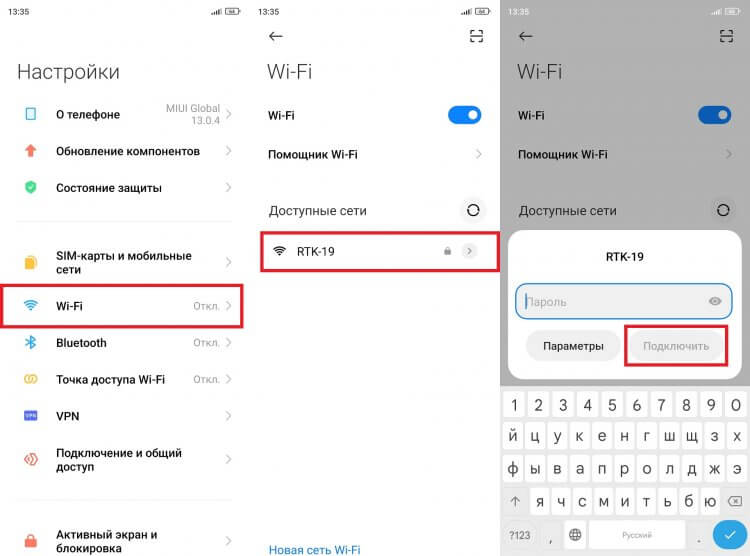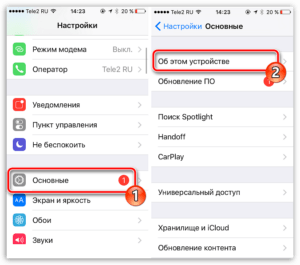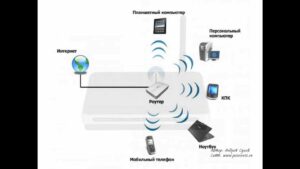- Step by step: setting up a Wi-Fi connection
- Connecting to a network using a password
- Setting up a router for uninterrupted Internet
- Wired Internet Setup Basics
- Connecting to the network via an Ethernet cable
- Solving wired connection problems
- Setting up the Internet on a mobile device
- Connect to Wi-Fi on a smartphone or tablet
- Using mobile internet while traveling
- Additional tips for setting up the Internet
- Updating drivers for network cards
- Optimizing browser settings to speed up page loading
Step by step: setting up a Wi-Fi connection
Beginner users may have difficulty setting up a Wi-Fi connection on their devices. But don't worry, all the necessary steps are described below:1. Check the presence of a wireless network: make sure that your router is working and the device has a Wi-Fi wireless module.2. Find available Wi-Fi networks: On your device, find a list of available Wi-Fi networks, select the one you need and enter the password (if available).3. Check your connection: Make sure your device is successfully connected to the selected Wi-Fi network. 4. Check your connection speed: Check your connection speed using special applications or built-in tools in your browser.5. Protect your network: Don't forget to set up security for your Wi-Fi network to prevent unauthorized access to your data. Now you can enjoy fast and secure internet access on your device.
Connecting to a network using a password
If your Internet service provider requires you to enter a password to connect to the network, you should follow these steps:
1. Tap the Wi-Fi icon in the bottom right corner of the screen.
2. Select the name of the network you want to connect to and click the 'Connect' button.
3. Enter the password that was provided by your provider and click the 'Next' button.
4. If the password is correct, your computer will connect to the network.
If the password is incorrect or does not fit, you should contact your provider and request the correct password.
You should also make sure that your computer has the correct network settings and supports the appropriate Wi-Fi technology.
A proper network connection will allow you to use Internet services without problems or interruptions.
Setting up a router for uninterrupted Internet
In order to configure your router and ensure uninterrupted Internet, you need to follow a few simple steps.
1. First of all, you need to connect the router to your Internet provider. To do this, you will need an Ethernet cable, which you must plug into the WAN port on your router and into the Internet port on your wall.
2. Next, you need to connect all devices to your router. To do this, use Ethernet cables that connect to the LAN ports on your router and to the network ports on your device.
3. Once all devices are connected, you can start setting up your router. To do this, you need to log into the router's web interface using your username and password.
4. After entering the router interface, you can configure your network settings such as SSID (name of your Wi-Fi network), password, channel, etc.
5. Don't forget to also set up a DHCP server, which will automatically assign IP addresses to your devices connected to the network.
6. Finally, set up uninterruptible power for your router by connecting it to an uninterruptible power supply (UPS). This will allow your network to continue working even if there is a power failure.
By following these simple steps, you can set up your router and ensure uninterrupted internet in your home or office.
Wired Internet Setup Basics
Let's start by connecting the wire from the provider to the computer. Usually the provider provides a modem that needs to be connected to a wire and to a computer. Then you need to configure the connection using the provider data, which can be found on the provider’s website or obtained from its technical support.
After this, you need to install drivers for the modem, if they were not installed automatically, and configure the network. To do this, you need to find the 'Network and Internet' section on your computer and select 'Set up an Internet connection'. Then follow the instructions and enter the information you received from your provider.
After setting up the connection, you can check its functionality by opening a web browser and entering the address of any site. If the page has loaded, it means the Internet is working.
It is also important to make sure that your computer is protected from viruses and other Internet threats. To do this, you need to install antivirus software and update it regularly.
By following these simple steps, you can easily set up a wired Internet connection and enjoy its speed and convenience.
Connecting to the network via an Ethernet cable
An Ethernet cable is a cable that is used to connect devices to the Internet. If you have an Ethernet cable and access to a router, you can connect your device to the Internet.
Step 1: Connect the Ethernet cable to the router
First, you need to find a router and find a free Ethernet port on it. Connect one end of the Ethernet cable to your router into this port.
Step 2: Connect the Ethernet cable to the device
Then connect the other end of the Ethernet cable to the Ethernet port on your device. This port may be named 'Ethernet', 'LAN' or 'Network'. It is usually located on the back of the device.
Step 3: Set up your Internet connection
Once the Ethernet cable is connected to the router and device, you should see a network icon on your device. If you can't connect to the Internet, try rebooting your device and checking that the Ethernet cable is properly connected.
Now you know how to connect your device to the Internet using an Ethernet cable. This is a fast and reliable way to connect to the Internet.
Solving wired connection problems
If you are having problems with your wired Internet, do not despair: there are several simple ways to solve the problem.
First, check if the Ethernet cable is connected correctly. It should be securely plugged into the network port on your computer and router. If this doesn't help, try rebooting your router and computer.
Second, make sure your operating system has the correct network settings configured. To do this, open the control panel and find the 'Network and Internet' section. Make sure you have the correct network type selected (private or public) and that your network settings are not blocking Internet access.
If these steps don't help, try updating your network card drivers. You can download them from your computer manufacturer's website or contact a specialist for help.
Finally, if all of the above methods fail, the problem may be due to a faulty Internet service provider. Contact your provider for further help and support.
All these tips will help you solve your wired connection problems and enjoy a smooth internet experience.
Setting up the Internet on a mobile device
Setting up the Internet on a mobile device may seem like a daunting task for beginners. But it's actually very simple if you know the right steps.
First of all, you need to choose your mobile operator and find out what settings are needed to connect to the Internet. Typically, operators provide instructions on their websites or in stores.
Then, you need to go to the settings of your device and select 'network and internet'. In this section you will find a 'mobile networks' option where you can enter the settings you received from your operator.
If you have problems connecting to the Internet, try restarting your device or check that you have entered the correct settings.
We hope that these simple steps will help you set up the Internet on your mobile device and you can enjoy its benefits.
Connect to Wi-Fi on a smartphone or tablet
Wi-Fi is one of the most popular ways to connect to the Internet on smartphones and tablets. To connect to Wi-Fi, you need to follow a few simple steps:
1. Open your device settings and find the Wi-Fi section.
2. Turn on Wi-Fi if it's not already on.
3. Select an available Wi-Fi network from the list.
4. Enter the password if the network is password protected.
5. Click the 'Connect' button.
After this, you will successfully connect to Wi-Fi and can surf the Internet on your device. Remember to turn off Wi-Fi when not in use to conserve battery power.
It's also a good idea to save your Wi-Fi passwords so you don't have to re-enter them every time. Some devices also have the ability to automatically connect to your preferred Wi-Fi networks, making the process even more convenient.
Now you know how to connect to Wi-Fi on your smartphone or tablet. It's a simple and convenient way to access the Internet anywhere there is Wi-Fi.
Using mobile internet while traveling
Mobile Internet has become an integral part of our daily lives and is especially important when traveling. But what to do if you don’t know how to set up the Internet on your smartphone? In this complete beginner's guide, we'll show you how to set up mobile internet on different carriers.
First, you need to make sure that you have an internet connection. To do this, open the settings on your smartphone and find the “Network and Internet” section. If you have a Wi-Fi connection, you will see that the network is connected. If not, then you need to choose your telecom operator and set up the Internet.
If you use the MTS telecom operator, then setting up the Internet will not be difficult for you. To do this, you need to open the settings, then select “Network and Internet” and click on “Mobile networks”. Next, select “Access Point Names” and click on “Add New Access Point”. Enter the name of the access point, for example, MTS, and configure other parameters that are indicated on the operator’s website.
If you use the Beeline telecom operator, then setting up the Internet is also simple. To do this, open the settings, select “Network and Internet” and click on “Mobile networks”. Next, select “Access Point Names” and click on “Add New Access Point”. Enter the name of the access point, for example, Beeline, and configure other parameters that are indicated on the operator’s website.
Now that you have set up the Internet, you can safely use it while traveling. Don't forget to make sure that you have enough traffic so that you won't be left without internet at the most inopportune moment. And remember that you can always contact your carrier’s support service if you have problems with the Internet while traveling.
Additional tips for setting up the Internet
Once you've set up your internet connection, there are a few additional tips to help you get the most out of your ISP.
1. Use optimal browser settings. Some browsers may have settings that slow down your Internet connection. Make sure you are using the latest version of your browser and set it for maximum performance.
2. Optimize your network. If you have multiple devices connected to the Internet, they may compete for connection speed. Optimize your home network so devices don't interfere with each other.
3. Update your drivers. Outdated drivers can cause problems with your Internet connection. Keep all drivers on your computer updated to ensure maximum performance.
4. Clear your browser cache. Browser cache can slow down your internet connection if it gets too large. Clear your cache regularly to maintain peak performance.
5. Use antivirus software. Viruses and other malware can slow down your Internet connection. Install antivirus software and update it regularly to ensure maximum protection.
By following these additional tips, you can get the most out of your ISP and enjoy a fast, reliable connection.
Updating drivers for network cards
One of the most common Internet connection problems is problems with network cards. If your network card is not working properly, you may experience connection problems or may not be able to connect to the Internet at all. In this case, the solution may be to update drivers for network cards.
Typically, drivers for network cards are installed along with the operating system, but sometimes they may require updating. Updating your drivers will help fix problems with your Internet connection and also improve your connection speed.
To update drivers for network cards, you need to know the model of your network card. This information can be found in the Devices and Printers menu in your computer's Control Panel. Once you have found out the model of your network card, you can find and download the appropriate drivers on the manufacturer's website.
Updating drivers for network cards is a quick and easy way to fix Internet connection problems. If you are having problems connecting to the Internet, try updating your network card drivers and you may be able to fix the problem yourself.
Optimizing browser settings to speed up page loading
One of the reasons for slow page loading may be an incorrectly configured browser. The following settings will help speed up page loading:
1. Clear cache and browser history. Accumulated files can slow down page loading, so it is recommended to periodically clear your cache and browser history.
2. Disable extensions. Some extensions can slow down your browser, so it is recommended to disable unnecessary extensions.
3. Using lightweight browsers. Some browsers, such as Google Chrome or Mozilla Firefox, can be heavy and slow down your computer. In this case, it is recommended to use lightweight browsers such as Opera or Midori.
4. Use of ad blockers. Ads can slow down page loading, so it is recommended to use ad blockers such as AdBlock or uBlock Origin.
5. Changing browser settings. Some browser settings, such as enabling data compression or disabling image loading, can make pages load faster.
By following these recommendations, you can speed up page loading and make your Internet experience more comfortable and efficient.
Read further:






